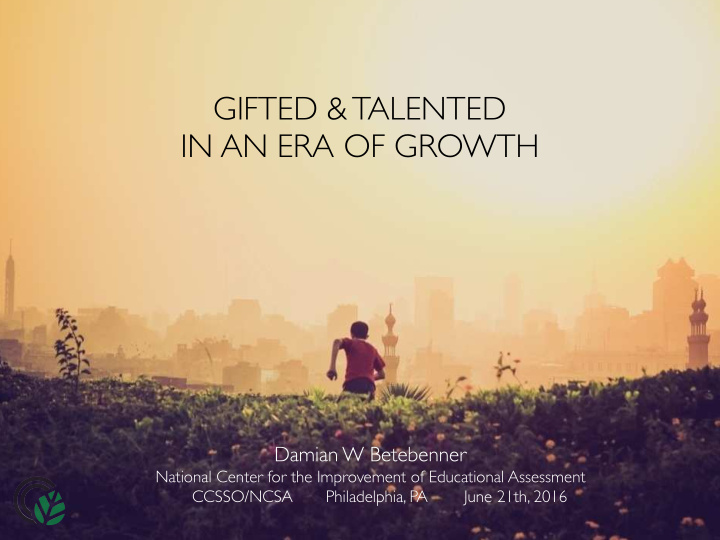



GIFTED & TALENTED IN AN ERA OF GROWTH Damian W Betebenner National Center for the Improvement of Educational Assessment CCSSO/NCSA Philadelphia, PA June 21th, 2016
Gifted & Talented “Children and youth with outstanding talent who perform or show the potential for performing at remarkably high levels of accomplishment when compared with others of their age, experience, or environment.” – US Department of Education, 1993
Gifted & Talented • As the definition suggests, gifted & talented is often associated with extraordinary levels of attainment. • Gifted connotes “natural ability” • How do we square this definition within a growth based view of the world. • Carol Dweck (2010): Growth Mindset • Angela Duckworth (2007): Grit
Growth Mindset • Based upon research done with students identified as gifted and talented. • Studied the effect of praise on students in a dozen New York schools. • Explicated difference between fixed and growth mindsets of students. • Fixed mindset consonant with belief in innate gifts (e.g., intelligence).
Growth Mindset • Those who think that innate intelligence is the key to success begin to discount the importance of effort. • I am smart, the kids’ reasoning goes; I don’t need to put out effort. • Striving seen as a sign of weakness by gifted students (can’t cut it with your natural gifts). • Giving kids the label of “gifted” does not prevent them from underperforming. It might actually be aiding it.
Grit • Duckworth (2007) investigated perseverance and passion for long-term goals (i.e. grit) on long term achievement. • Showed significant impact on long-term educational attainment. • Not correlated with IQ. • Despite importance, Duckworth warns against attempts to quantify grit for inclusion in accountability systems.
Strivers versus Naturals • Recent research suggests a cultural bias in favor of naturals over strivers. • Tsay (2016) “We are willing to give up better-qualified candidates in order to hire those believed to be naturals.” • Showed 900 U.S. investors fictional profiles of entrepreneurs. • Investors strongly favored naturals over strivers
Strivers versus Naturals • Recent research suggests a cultural bias in favor of naturals over strivers. • Tsay (2016) “We are willing to give up better-qualified candidates in order to hire those believed to be naturals.” • Showed 900 U.S. investors fictional profiles of entrepreneurs. • Investors strongly favored naturals over strivers
Gifted & Talented: My Experience • In 7th grade, moved into 8th grade math class because I received a high grade on the first test. • 8th grade - 11th grade classes were standard math classes. 12th grade class was calculus. • A seminal fixed-mindset experience: Provided external validation of what I was “good at”. Conversely, what I wasn’t good at were the classes I didn’t get gifted placement in. • Who would I be today if I hadn’t made the choice chose to jump to 8th grade math?
MY WORK: • Have worked with SEAs over the last decade to calculate and investigate student growth. • Developed student growth percentiles (SGPs) as a way of discussing student growth. • SGPs incorporate norm- and criterion-referenced (growth to standard) component. • Growth of ALL students high/low achievers represented in the model (e.g., move-up growth).
Explosive growth! Reading Advanced Achievement ● Move Up ● ● ● Target DEMO Reading ● Scale Score ● ● ● ● Keep Up Target ● ● ● Growth Catch Up ● ● Proficient Target ● Level Percentiles ● Very High 81st − 99th High 61st − 80th Part Proficient Typical 40th − 60th Low 20th − 39th ● Very Low 1st − 19th Unsatisfactory Grade 3 Grade 4 Grade 5 Grade 6 Grade 7 2009 − 2010 2010 − 2011 2011 − 2012 2012 − 2013 2013 − 2014 Scale Score 449 533 579 602 Achievement Achievement Level Unsatisfactory Part Proficient Part Proficient Proficient Achievement Target Proficient (592) Proficient (620)/Advanced (661) Growth Percentile 69 85 74 Growth Growth Level High Very High High Growth Target Catch Up (60) Keep Up (76)/Move Up (99)
Gifted & Talented • How can growth inform gifted and talented placement? • Can the notion of gifted and talented exist without a fixed mindset? • Can gifted and talented enable grit and perseverance?
Gifted & Talented Growth as an indicator of potential “Children and youth with outstanding talent who perform or show the potential for performing at remarkably high levels of accomplishment when compared with others of their age, experience, or environment.” – US Department of Education, 1993
References Duckworth, A.J., Peterson, C., Matthews, M.D., and Kelly, D.R. (2007) Grit: Perseverance and Passion for Long-Term GoalsJournal of Personality and Social Psychology, 2007, Vol. 92, No. 6, 1087–1101 Dweck, C. S.; Leggett, E. L. (1988). "A social-cognitive approach to motivation and personality". Psychological Review 95 (2): 256–273. Dweck, C. S. (2010). “Mind-Sets and Equitable Education”. Principal Leadership 10 no5 January 2010 Tsay, CJ. (2016) Privileging Naturals Over Strivers: The Costs of the Naturalness Bias. Pers Soc Psychol Bull. 2016 Jan;42(1):40-53.
Recommend
More recommend